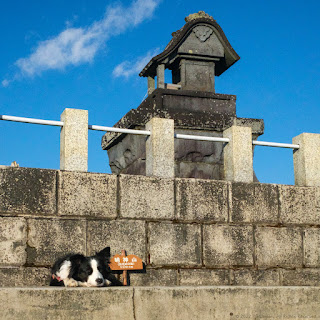Pentax K-1 II + DFA 28-105mm F3.5-5.6
34 mm ISO 100 for 1/250 sec. at ƒ/9.0
Teppo-Kinokashira| Myojinyama Mountain Peaks in Yamanashi Pref., Japan
Rising a mere 1,291 m (4,235.56 ft) above sea level, the peak of Myōjinyama Mountain (鉄砲木ノ頭 or 明神山)offers lovely views of Yamanako Lake to the west and grand views of Mt. Fuji to the southwest (on a clear day).
The mountain is basically composed of ancient mounds of volcanic pumice from Mt. Fuji’s most recent eruptions thus creating conditions that are not ideal for heavy tree growth but perfect for grassy species like susuki!
Sadly the pumice is unstable and is susceptible to heavy corrosion from hiking trails where the susuki plant life has been killed and can no longer hold the soil together sufficiently.
This small mountain is popular for novice hikers and suitable for paragliding. My main attraction to this mountain were the fields of susuki grass, which provide a golden, beautiful foreground to the vast landscape of Mt. Fuji and the heart-shaped Lake Yamanakako.
Pentax K-1 II + DFA 28-105mm F3.5-5.6
28 mm ISO 100 for 1/160 sec. at ƒ/16
Eastern Slope of Mt. Fuji
The Japanese pampas grass (susuki) in the foreground stands in stark contrast with the dark afternoon shadow cast across the eastern slope of Mt. Fuji.
I had hoped to catch a snow-capped Mt. Fuji, but the autumn sun had already melted the snow before I had a chance to visit the summit of Teppoginoatama (鉄砲木ノ頭)--also known as Myojinyama (明神山).
November seems to be the most popular time of the year to climb this small mountain as many people want to catch a shot of the golden pampas grass with a panoramic view of Lake Yamanaka to the northwest and Mt. Fuji to the southwest.
Pentax K-1 II + DFA 28-105mm F3.5-5.6
45 mm ISO 100 for 1/400 sec. at ƒ/14
Okumiya of Yamanaka Suwa Shrine (山中諏訪神社の奥宮)
The tiny Okumiya of Yamanaka Suwa Shrine is located at the summit of Mt. Myojin (明神山) in Yamanashi Prefecture, Japan, and enshrines two deities dedicated to the safety of hikers and visitors to the summit and the fields of pampas grass.
Names of the enshrined deities are Takeminakata-no-Mikoto (建御名方命) and Toyotamahime-no-Mikoto (豊玉姫命).
The date this shrine was established remains a mystery, but ancient documents make reference to the presence of the shrine on the summit of Mt. Myojin.
In 1841, the original shrine was moved to make way for land surveys carried out under the command of Lord Okubo of Odawara Castle in Kanagawa Prefecture.
Many years later, volunteer historians and shrine officials discovered the original location of the shrine and returned it to the summit of Mt. Myojin where it resides today.
A festival is held on September 1st of each year to commemorate return of the shrine to its home and to pray for the safety of visitors to the shrine.
Fujifilm X100V (23 mm) with 5% diffusion filter
ISO 160 for 1/500 sec. at ƒ/3.2
Classic chrome film simulation
Border Collie on Summit
She is taking a well-deserved break in the shade of tall pampas grass at the summit of Mt. Myojinyama with the peak of Mt. Fuji in the background.
Fujifilm X100V (23 mm) with 5% diffusion filter
ISO 160 for 1/280 sec. at ƒ/2.2
Provia/Standard film simulation
Japanese Maples and Susuki Grass
Lone Japanese maples (momiji・モミジ・紅葉) located at the edge of a tight curve on Prefectural Highway 730 next to the parking lot of the trailhead where you can take a hike to the peak of Mt. Myojin (明神山)in Yamanashi Prefecture.
The early evening sun lit up this scene perfectly! It is possible to catch this shot with Mt. Fuji in the background, but you will have to be very patient (or arrive very early) and wait for a clean shot with no cars, motorbikes, or people in the shot.
After climbing to the summit, you can head down to Lake Yamanakako, which is only a six-minute drive from the trail head, or head in the opposite direction and visit the Fuji International Speedway, which is only a 15-minute drive from the trail head.
Highway 730 is a twisty road with tight curves and steep inclines and is the main mountain pass between Lake Yamanaka and Fuji International Speedway. This highway seems to be very popular among motorcycle riders and sports car drivers!
Fujifilm X100V (23 mm) with 5% diffusion filter
ISO 160 for 1/500 sec. at ƒ/3.2
Provia/Standard film simulation
Camera-Shy Mt. Fuji
Mt. Fuji was very camera-shy while I was at the summit of Mt. Myojin (明神山) in Yamanashi Prefecture. It was difficult to catch any clean shot where she wasn’t hiding behind cloud cover.
Fortunately, the late-afternoon sun helped bring out the golden tones of susuki (Japanese pampas grass).
Fujifilm X100V (23 mm) with 5% diffusion filter
ISO 160 for 1/420 sec. at ƒ/2.8
Provia/Standard film simulation
Pampas Grass & Lake Yamanaka, Japan
View of Lake Yamanaka (山中湖) from the trailhead that leads to the peak of Mt. Myojin (明神山)in Yamanashi Prefecture where you can enjoy lovely views of the lake and grand views of Mt. Fuji to the southwest (on a clear day).
Access to the trailhead is only a 45-minute drive from the Shin-Hadano Exit on the Tomei Expressway. The trailhead includes restrooms, picnic tables, and free parking.
Fujifilm X100V (23 mm) with 5% diffusion filter
ISO 2500 for 1/250 sec. at ƒ/16
Provia/Standard film simulation
Sleepy Border Collie at the Okumiya of Yamanaka Suwa Shrine
(山中諏訪神社の奥宮)
The tiny shrine is located at the summit of Mt. Myojin in Yamanashi Prefecture, Japan, which offers grand views of Lake Yamanaka (one of the Five Lakes of Mt. Fuji), and views of Mt. Fuji (on a clear day) with a foreground of waving fields of susuki pampas grass.

Pix4Japan by Iketani, Daisei is licensed under a
Creative Commons Attribution-NonCommercial-ShareAlike 4.0 International License.
Permissions beyond the scope of this license are available at Pix4Japan.











































